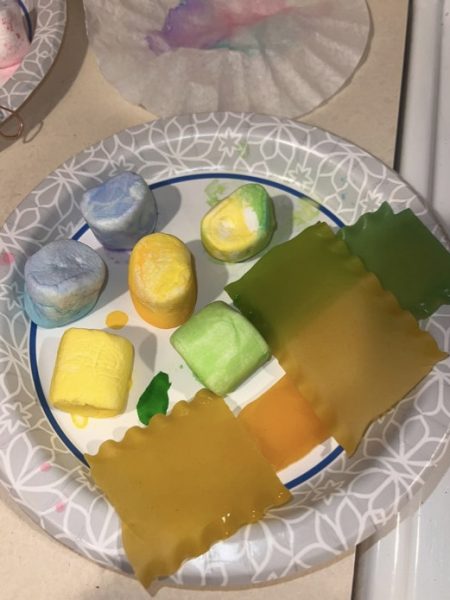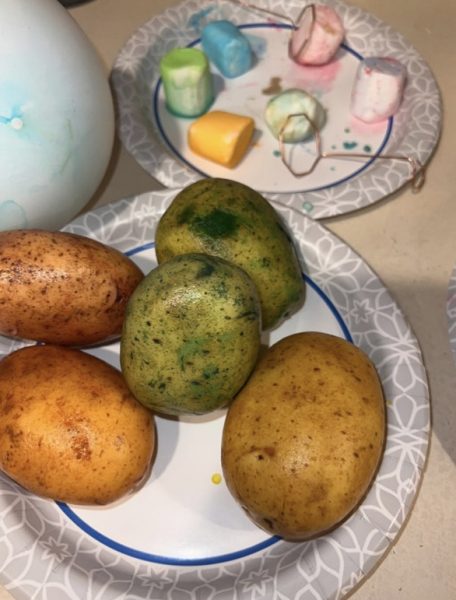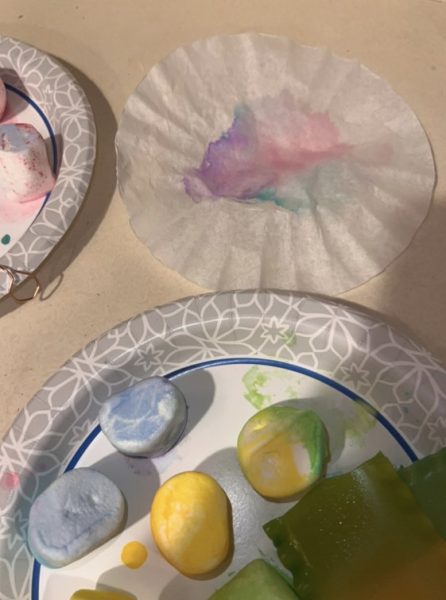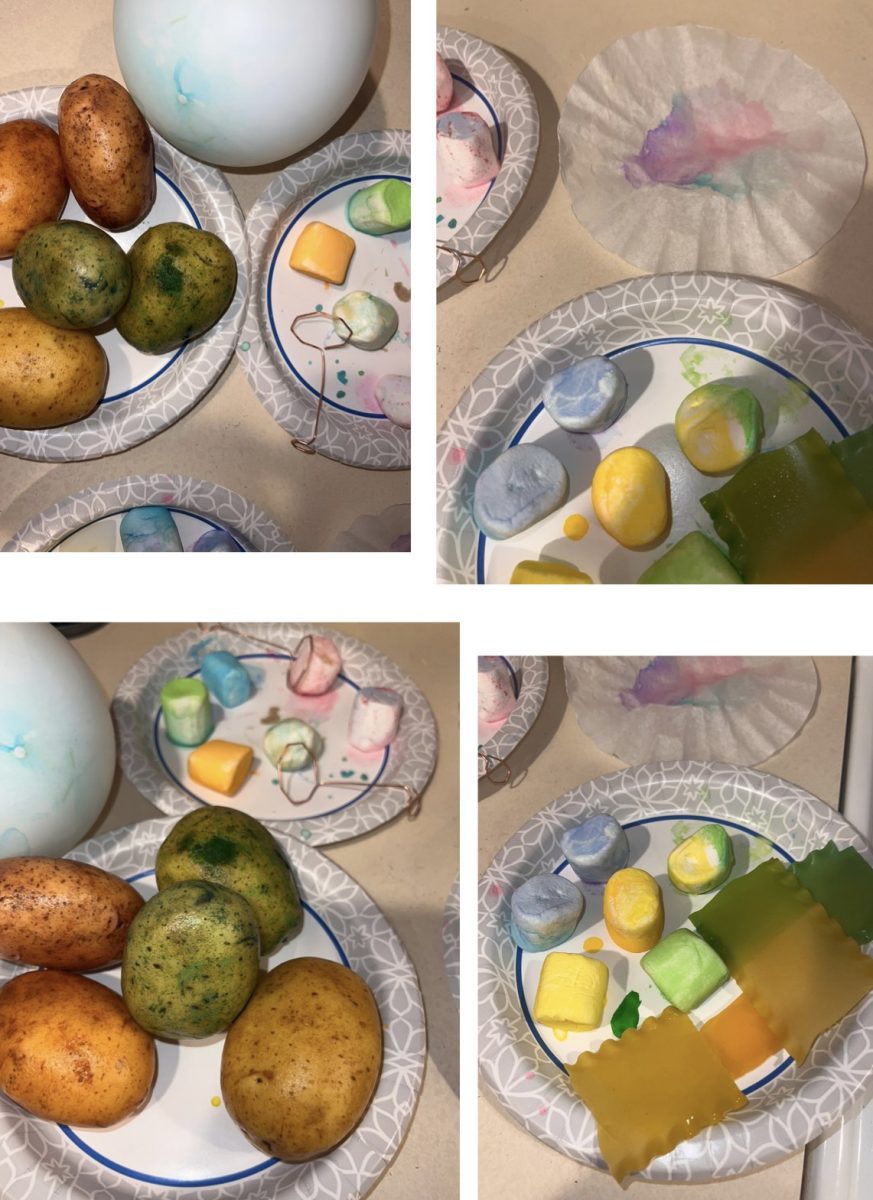This Easter, I tested alternatives for Easter eggs and dyed them so you don’t have to, and let’s just say, I’d stick with the real ones.
Egg prices are steep right now, courtesy of a bird flu outbreak and the resulting customer demand for a somewhat scarce resource. There’s never a good time for eggs to be expensive, but at Easter time, it is even worse.
It is a popular tradition to dye eggs with food dye, markers, or even whipped cream. However, the price of eggs can put a damper on that treasured and nostalgic experience. On Easter, I set out to look for more economical replacements, some of which might already be in your home.
For this experiment, I tested marshmallows, potatoes, coffee filter paper, white balloons, and pasta. Each one had a unique set of advantages and setbacks. I used a Paas egg-dyeing kit for everything except the coffee filter paper.
“I thought the idea sounded kind of crazy, but I was interested to see how it would turn out, and I knew there was no backing out,” Lainey Fitzpatrick, my sister and my Easter dye helper, said.
The marshmallows were the most successful substitution, in my opinion. I dunked them in the cups with the dye, and they easily absorbed the colors in a matter of seconds. The marshmallows had a very pretty watercolor effect, and all of the colors, regardless of shade, turned out to be very vivid.
The marshmallows were the regular-sized white ones and were priced at $1.29 at Kroger. They were not flawless, though, and there were challenges. The marshmallows did not sink in the dye; they kept floating to the surface. This meant they had to be held in the dye in order to fully submerge.
This made it difficult to do multiple colors on a single marshmallow as well. In order to do dual-colored ones, I had to hold the marshmallow halfway down in the dye for one color and then flip it to hold onto the other side and do the same with a different dye color. The dyed side I had to hold onto got very sticky and slippery, so it was hard to get a good grip.
The marshmallows took a long time to dry and were still a little mushy even after sitting for hours. This is most likely due to the marshmallow’s absorbent texture. They turned out very pretty, but there were some logistical issues with them. As far as shape goes, they are fairly similar to an Easter egg.
“Out of everything we dyed, they turned out the best with the color, but they felt slimy, and when we did multiple colors, they got a little gross,” Fitzpatrick said.
The pasta was the next biggest success. Pasta is not really Easter egg-shaped, but it does absorb color well. I used some broken lasagna noodles I already had, and it did not take long for them to become colorful after they were dipped in the dye.
Since pasta is not pure white, darker colors like blue and green were most effective; it was more difficult to see the yellow and orange dye on the pasta. The pasta dried quickly and retained its hard texture. A ravioli pasta might have been a better candidate to achieve more of a traditional Easter egg appearance.
A box of lasagna noodles at Kroger’s costs $1.50.

For the potatoes, I used Yukon Gold potatoes, and in hindsight, it was probably a mistake. I should have used baby or fingerling potatoes, but Kroger did not have them in stock, so I stuck to what I could find.
I don’t think using baby potatoes would have changed the dye outcome much, but it would have been closer to an Easter egg shape and wouldn’t have taken up an entire red solo cup. When the potatoes were dunked in the dye, it became apparent that they were much too large, and some of the cups had less dye than others, causing the top of the potatoes to peek out of the cups.
I had high hopes for the potatoes, but my hopes were quickly mashed. I dunked the potatoes in, and even after sitting in the dye for several minutes, there was only a faint hue on them. I continued to let them sit in there for an additional 20 minutes, but there was little improvement.
After seeing their slow absorption, I decided to let them rest for eight hours while I attended to my plans for the day. I checked them right after returning, anxious to see the brightly colored potatoes that awaited me.
When I looked to see how they turned out, only the green and blue eggs had an obvious color, but that color made them look more like moldy potatoes than pretty Easter eggs. The bag of potatoes cost $4.99 at Kroger, and thankfully, I did not dye all of them.
“The potatoes were kind of a waste of time,” Fitzpatrick said. “They were not pretty; they looked gross.”

I found some leftover white balloons I had lying around, so I put them to the test as well. I dunked it in the Easter egg dye.
This one was a total failure.
The dye ran right off the balloon; only a little residual dye gave it a faint coloration.
After allowing the balloon to dry for several hours, I blew it into a small round shape. The blue dye had only left a faint trace. This experiment was a flop.
The coffee filter paper required a different tactic. I used different colored highlighters to draw scribbles onto the round middle part. Then, I lightly splashed the color with water.
The color began to spread across the coffee filter, and the colors ran into each other to create a blended look. The way the colors spread resembled a true Easter egg, but the downside was that the water made the paper very thin. Coffee filter paper is already sheer, but the water made it almost entirely translucent.
To complete the coffee filter craft, the filter paper can be cut into an egg shape and glued or taped to a thicker cardstock to help keep its shape. I didn’t take it that far, but I was satisfied with the color.

“After we got done, my hands were stained,” Fitzpatrick said. “Even though the results weren’t the greatest, I felt like it was still a success, so we could say we did it and share our experience with others.”
These were all fun projects to do once. Admittedly, none of them compares to a real egg, but for a quick science experiment, they were worth a try. Some of these options are more cost-effective than real eggs, and in times of major inflation, they offer a way to continue to make traditions accessible to all.
Next Easter, I’d encourage you to be brave and try some of these out, but hopefully by then, egg prices will be back to normal.


